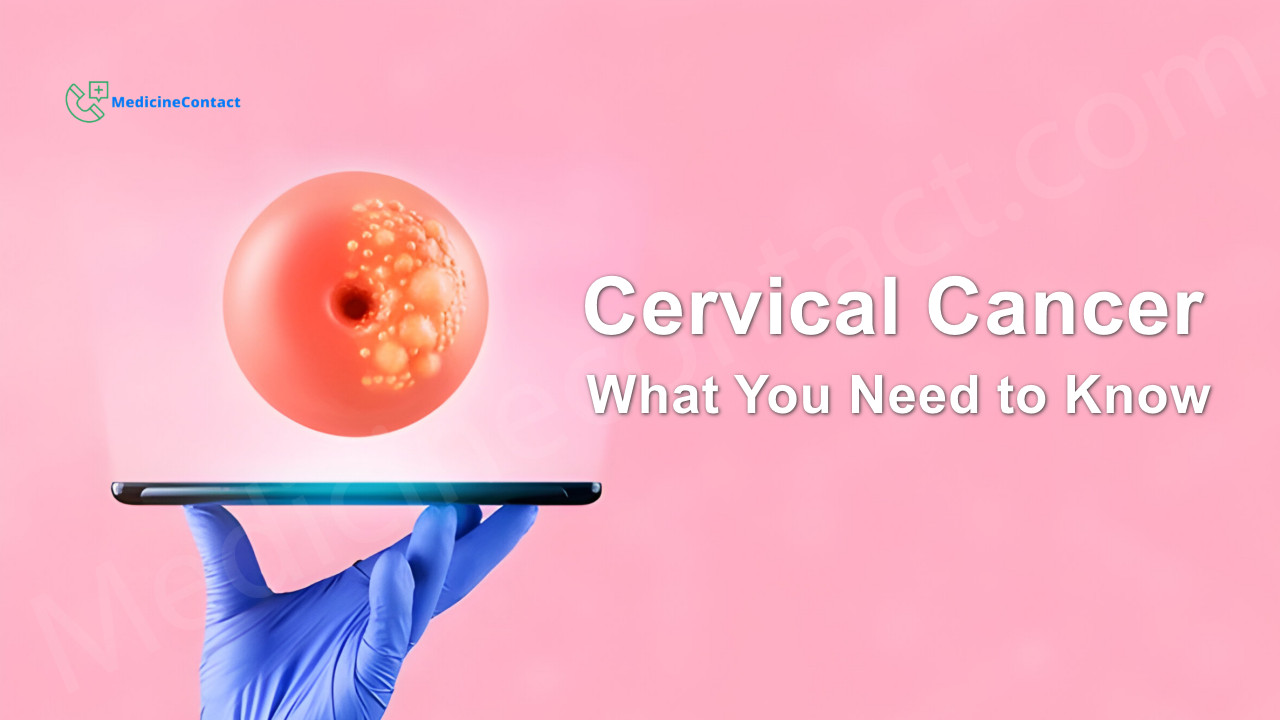
Introduction
Cervical cancer is the fourth most common cancer among women globally, with nearly 660,000 new cases and 350,000 deaths reported in 2022. Understanding the impact of this disease on women's health is crucial.
Human papillomavirus (HPV) infection stands as the primary cause of cervical cancer. HPV is a common sexually transmitted infection. Persistent infection with high-risk HPV types can lead to the development of cervical cancer, making awareness and education about HPV essential for prevention.
Cervical screening plays a pivotal role in detecting abnormalities early and preventing cervical cancer. Methods like the Pap test help identify precancerous changes before they develop into full-blown cancer. Regular screening ensures early intervention, significantly reducing the mortality rate associated with cervical cancer.
Taking proactive steps such as understanding HPV and participating in regular screenings can empower individuals to take control of their reproductive health.
Understanding Cervical Cancer: Types, Statistics, and Risk Factors
Types of Cervical Cancer
Cervical cancer primarily appears in two forms:
- Squamous Cell Carcinoma: Starts in the thin, flat cells lining the outer part of the cervix. This type makes up about 90% of cervical cancer cases.
- Adenocarcinoma: Develops in the glandular cells that line the cervical canal. Although less common, its occurrence has been rising in recent years.
Global Statistics
According to recent cervical cancer statistics, this disease ranks as the fourth most common cancer among women worldwide. In 2022, around 660,000 new cases were diagnosed globally, resulting in approximately 350,000 deaths. Despite these alarming numbers, cervical cancer remains highly preventable through regular screening and vaccination.
Risk Factors
Several key risk factors contribute to the development of cervical cancer:
- Persistent HPV Infection: Nearly all cervical cancers are linked to long-term infections with high-risk human papillomavirus (HPV) types.
- Smoking: Tobacco use doubles the risk of developing cervical cancer by contributing to DNA damage.
- Weakened Immune System: Conditions such as HIV/AIDS lower the body's ability to fight off HPV infections effectively.
- Other Factors: Early sexual activity, multiple pregnancies, family history of cervical cancer, and exposure to diethylstilbestrol (DES) also increase risk.
Understanding these types, statistics, and risk factors provides a comprehensive overview of cervical cancer, highlighting its preventable nature through proactive measures like screening and vaccination.
The Link Between Human Papillomavirus (HPV) and Cervical Cancer
Human papillomavirus (HPV) is a common sexually transmitted infection that can spread through intimate skin-to-skin contact. Most sexually active people will get HPV at some point in their lives, often without knowing it.
Types of HPV
HPV types fall into two main categories:
- Low-risk HPV types: These are generally associated with non-cancerous conditions, such as genital warts.
- High-risk HPV types: These pose a significant risk of leading to cancers, notably cervical cancer. Among these, HPV types 16 and 18 are responsible for the majority of cervical cancer cases.
How HPV Leads to Cervical Cancer
A persistent infection with high-risk HPV types can cause changes in cervical cells, potentially developing into cancer over time. Screening methods like the Pap test and HPV testing help identify these changes early on.
For instance, an ASC-US result with positive high-risk HPV indicates atypical squamous cells of undetermined significance accompanied by a high-risk HPV infection. This often requires further evaluation to determine the appropriate course of action.
Understanding the Timeline
The time it takes for HPV symptoms or abnormal cells to appear varies; it can take months or even years after exposure. Staying informed about HPV positive ICD 10 codes can facilitate accurate medical documentation and treatment planning.
Cervical Screening: Methods, Guidelines, and Recommendations
Primary Methods of Cervical Screening
Cervical screening is essential for early detection of abnormalities that may indicate cervical cancer. The two primary methods are:
- Pap Test (Pap Smear): This test involves collecting cells from the cervix to check for epithelial cell abnormalities that might signify precancerous changes or cervical cancer itself.
- HPV Testing: This method detects the presence of high-risk HPV types known to be associated with cervical cancer. It is often employed in conjunction with a Pap test to provide a comprehensive evaluation.
Screening Recommendations by Age Group
Reputable health organizations like the American Cancer Society provide detailed guidelines for cervical screening based on age groups:
- Women aged 21-29: Recommended to have a Pap test every three years.
- Women aged 30-65: Options include:
- A Pap test every three years.
- An HPV test every five years.
- Co-testing (both Pap and HPV tests) every five years.
Regular screenings are crucial for early detection and prevention, helping to significantly reduce the incidence of cervical cancer.
What Happens During a Pap Test? Understanding Results Like ASC-US and High-Risk HPV
Step-by-Step Explanation of a Pap Test
A Pap test, also known as a Pap smear, is a straightforward procedure aimed at detecting precancerous or cancerous cells in the cervix. Here’s how it typically unfolds:
- Preparation: The patient lies on an examination table with feet placed in stirrups.
- Speculum Insertion: A speculum is gently inserted into the vagina to widen it, allowing access to the cervix.
- Sample Collection: Using a small brush or spatula, the healthcare provider collects cells from the cervix.
- Cell Preservation: The collected cells are preserved in a solution or smeared on a glass slide for laboratory analysis.
Common Pap Test Results
Understanding your Pap test results can be crucial for your health management:
- Normal (Negative): No abnormal cells detected. Routine screening continues as per guidelines.
- ASC-US (Atypical Squamous Cells of Undetermined Significance): Cells appear slightly abnormal but not definitively pre-cancerous. This often warrants further testing, such as an HPV test, to determine if high-risk HPV types are present.
- HPV Positive Pap: Indicates the presence of high-risk HPV strains, which may require closer monitoring or additional diagnostic procedures like colposcopy.
- High-Risk HPV: Specific high-risk types of HPV, such as HPV 16 and 18, significantly increase the risk of cervical cancer.
Each result guides subsequent steps in managing your reproductive health effectively.
Diagnosing Cervical Cancer: From Abnormal Screening to Confirmation
When an abnormal screening result arises, it acts as a critical alert for the need for further diagnostic tests for cervical cancer. The typical diagnostic process begins with follow-up screenings to clarify initial findings.
1. Repeat Pap Test or HPV Test
Depending on the initial results, healthcare providers may recommend repeating the Pap test or conducting an HPV test to ascertain the presence of high-risk HPV strains.
2. Colposcopy
If abnormalities persist, a colposcopy is performed. This procedure involves using a colposcope to magnify and closely examine the cervix's surface, enabling the identification of abnormal areas that may require a biopsy.
3. Biopsy
During a colposcopy-directed biopsy, small samples of cervical tissue are collected from suspicious areas. These samples are then sent to a laboratory for histopathological examination to determine if cancerous cells are present.
4. Endocervical Curettage (ECC)
Sometimes, an ECC is performed alongside a biopsy. This involves scraping cells from the cervical canal to check for abnormalities higher up in the cervix.
The role of colposcopy-directed biopsy is paramount in confirming cervical cancer's presence. It offers a detailed view of any potential lesions and ensures that tissue samples collected are precisely from abnormal areas, enhancing diagnostic accuracy.
Early detection through these methods significantly improves treatment outcomes and offers women better chances at successful management and recovery.
Treatment Options for Cervical Cancer: A Comprehensive Overview
Understanding treatment strategies for cervical cancer is crucial for effective management. Here, we'll explore various modalities available depending on the stage of the disease.
Surgical Options
Hysterectomy
Often recommended for early-stage cervical cancer, this procedure involves the removal of the uterus and possibly surrounding tissues. Variants include:
- Total hysterectomy: Removal of the uterus and cervix.
- Radical hysterectomy: Removal of the uterus, cervix, part of the vagina, and surrounding tissues.
Trachelectomy
This fertility-sparing surgery removes the cervix while preserving the uterus, suitable for early-stage cancer in younger women.
Radiation Therapy
Radiation therapy uses high-energy rays to target and destroy cancer cells. It can be employed:
- As a standalone treatment for specific stages.
- In combination with surgery or chemotherapy to enhance effectiveness.
Chemotherapy
Chemotherapy utilizes drugs to kill cancer cells or stop their growth. It's typically administered:
- In conjunction with radiation therapy (chemoradiation) for advanced stages.
- As a neoadjuvant treatment to shrink tumors before surgery.
- As an adjuvant treatment post-surgery to eliminate residual cancer cells.
Targeted Therapies
These innovative treatments focus on specific molecules involved in cancer growth. Examples include:
Bevacizumab (Avastin)
An anti-angiogenesis drug that inhibits blood vessel formation in tumors, used in combination with chemotherapy for advanced stages.
Each treatment strategy is tailored to individual patient needs based on factors like cancer stage, overall health, and personal preferences. Collaborating with a multidisciplinary team ensures comprehensive care and optimal outcomes.
Preventing Cervical Cancer Through Vaccination: The Role of HPV Vaccine
HPV vaccines have been a game-changer in the battle against cervical cancer. By targeting the high-risk types of human papillomavirus (HPV) responsible for most cervical cancers, these vaccines significantly reduce the risk of developing the disease.
How Effective is the HPV Vaccine?
The effectiveness of the HPV vaccine is well-documented. Clinical trials and real-world studies show that vaccinated individuals have a dramatically lower chance of acquiring infections from high-risk HPV types, particularly HPV-16 and HPV-18, which are linked to around 70% of cervical cancer cases worldwide.
Who Should Get the HPV Vaccine?
Health organizations recommend initiating HPV vaccination at a young age for optimal effectiveness:
- Girls and boys aged 9-14: This age group benefits most from the vaccine because it is ideally administered before any exposure to HPV through sexual activity.
- Catch-Up Options: Individuals up to age 26 who missed earlier vaccinations can still receive the vaccine. Some guidelines extend catch-up vaccinations to individuals aged 27-45 after consulting with their healthcare provider.
Conclusion
Regular screenings and vaccinations stand as key strategies for reducing cervical cancer incidence. The widespread adoption of HPV vaccines promises a future where cervical cancer becomes a rare disease.
For additional information on cervical cancer, read more articles of Cervical Cancer.
Living With a Cervical Cancer Diagnosis: Support Resources and Coping Strategies
Receiving a cervical cancer diagnosis can be an overwhelming experience. It's crucial to recognize the variety of support resources for patients with cervical cancer available to help navigate this challenging journey.
Types of Support Available
Online Communities
- Websites like CancerCare and Cervivor offer forums and discussion groups where patients can connect with others facing similar experiences.
- Social media platforms often host private groups dedicated to cervical cancer support, enabling patients to share their stories and advice.
Professional Counseling Services
- Many hospitals and cancer treatment centers provide access to oncology social workers or psychologists who specialize in helping patients cope with the emotional aspects of their diagnosis.
- Organizations such as the American Cancer Society offer counseling services that can be accessed both in-person and virtually.
Patient Advocacy Groups
Groups such as the National Cervical Cancer Coalition (NCCC) provide advocacy, awareness, and education resources specifically tailored for cervical cancer patients.
Support Hotlines
The National Cancer Institute and other organizations operate hotlines where trained professionals offer guidance, information, and emotional support.
Medical Services Related to Cervical Cancer Near You
The National Provider Identifier (NPI) number is a unique identification number assigned to healthcare providers in the United States. It serves as a way to identify and track healthcare professionals and organizations across various settings. Using an NPI number can help you find specific providers or facilities that offer cervical cancer-related services. Here are some resources to help you locate specialists and facilities:
- Speciality: Specialty doctors, clinics, and organizations offer personalized care and support, with over 1 million NPI numbers identifying healthcare professionals nationwide.
- Physicians: All NPI numbers of Physicians include gynecologists, oncologists, and primary care providers who specialize in cervical cancer care.
- Clinics: All of NPI numbers about Clinics offer personalized examinations, screenings, and follow-up care for patients.
- Hospitals: NPI Numbers for Hospitals provide comprehensive diagnostic services, treatment facilities, and supportive care.
- Nursing Service Related Providers: Many NPI Numbers about Nursing service-related providers offer essential support, education, and care coordination.
This will give you access to detailed information about the provider's specialties, location, and contact details.
Coping Strategies
- Educational Resources: Understanding your diagnosis, treatment options, and what to expect can empower you. Reputable websites like Mayo Clinic provide comprehensive overviews.
- Mindfulness Practices: Techniques such as meditation, yoga, or deep-breathing exercises can reduce stress and improve mental well-being.
- Peer Support: Engaging with fellow survivors through support groups or one-on-one mentorship programs can provide comfort and practical tips for managing day-to-day challenges.
These resources are designed to assist you in navigating the complexities of living with cervical cancer, ensuring that you're not alone on this journey.
Conclusion: Empower Yourself Against Cervical Cancer!
Key takeaways from article on cervical cancer awareness:
- Regular Screenings: Participate in routine cervical screening methods like the Pap test and HPV testing to detect abnormalities early.
- Vaccination: Get vaccinated against the human papillomavirus infection to significantly reduce the risk of developing cervical cancer.
Maintaining proactive measures for your reproductive health is crucial. Regular screenings and vaccinations are powerful tools in the fight against cervical cancer. Stay informed, stay protected.
FAQs (Frequently Asked Questions)
What is cervical cancer and what are its types?
Cervical cancer is a type of cancer that occurs in the cervix, the lower part of the uterus. The two main types of cervical cancer are squamous cell carcinoma and adenocarcinoma.
How does HPV relate to cervical cancer?
Human papillomavirus (HPV) is a sexually transmitted infection that is a major cause of cervical cancer. High-risk HPV types can lead to changes in cervical cells that may develop into cancer if not detected and treated early.
What are the recommended methods for cervical screening?
The two primary methods for cervical screening are the Pap test (Pap smear) and HPV testing. These tests help detect abnormalities in cervical cells, allowing for early intervention if necessary.
What does an abnormal Pap test result mean?
An abnormal Pap test result, such as ASC-US (Atypical Squamous Cells of Undetermined Significance), indicates that further evaluation may be needed. This could involve additional testing or monitoring to determine if there are any underlying issues.
What treatment options are available for cervical cancer?
Treatment options for cervical cancer vary depending on the stage of the disease and may include surgery (like hysterectomy), radiation therapy, chemotherapy, or targeted therapies. A healthcare provider can recommend the best approach based on individual circumstances.
How can vaccination help prevent cervical cancer?
Vaccination against HPV has significantly improved prevention efforts against this virus, which is responsible for most cases of cervical cancer. It is recommended for preteens but can also be given to older individuals as catch-up options.
Disclaimer: This article is for informational purposes only and does not constitute medical advice. Always consult with a healthcare professional before starting any new treatment regimen.




